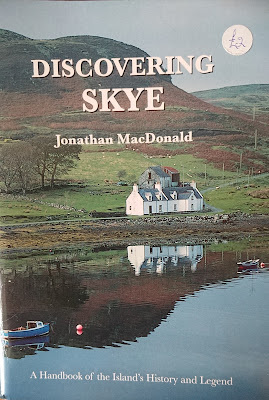The Day 2 prompt was: go to page 37 of the nearest non-poetry book and write something inspired by it. With most of my books still boxed, I pounced on my copy of “Discovering Skye” by Jonathan MacDonald, bought in Spring 2002, from memory. Page 37 reveals the relatively modern, very polite legend of Garrafad (*see below), and why the Kilmartin cemetery was not built there… I went with a pantoum, for some reason, though messed with the format a bit.
I don’t mind; I rarely mind
to hold these stones is all I ask.
I’m not the growling, hurting kind,
but most don’t see beneath my mask
To hold these stones is all I ask –
rain and wind and sky and fish –
but most can’t see beneath my mask…
some quiet – that’s my only wish.
Rain and wind and sky and fish…
I’d frankly rather sleep alone;
some quiet – that’s my only wish!
Downstream is better for your stone.
I’d frankly rather sleep alone;
I’m not the growling, hurting kind
downstream is better for their stones;
I rarely mind; tonight I mind.
Through the centre of Staffin runs the Kilmartin river noted for its salmon and its pearl-bearing mussels. Near the river is old Kilmartin cemetery which is sited where once stood a chapel dedicated to Saint Martin of Tours. A local story of how the cemetery was sited here is worth a mention. In the late eighteenth century there was occasion for a new burial ground to be set out for the area and the landlord of the time allocated a piece of land for the purpose on the slope above the river, known as Garrafad. Men were engaged to enclose the ground by drystone dyke and soon they took up their work and began to lay the foundations of the wall. When night fell they left their picks and shovels tidily beside their labours and proceeded home. Next morning they arrived at Garrafad to find their work undone and their tools missing, They were later found on the river bank beside the ruins of Saint Martin’s Chapel. The men duly recovered the tools and set to work again. That night they went home and left their tools at Garrafad as before, but when they arrived the following morning they found to their amazement that the same strange occurrence had taken place.
At last the workers were advised to keep an all night vigil at Garrafad and this they did, but to their astonishment nothing stirred the quiet of the night and no one came their way. In the morning however the tools were missing again and their work undone. They could not understand the strange happening and they did not wish to disclose it in case of being ridiculed by their fellows. Ultimately they sought the confidence and advice of a minister who advised them to abandon their place of work and to seek the landlord's permission to lay out the new burial ground on the spot where the tools were found each morning This they did and as soon as the work was begun at Kilmartin no interference was encountered and their work prospered.

No comments:
Post a Comment